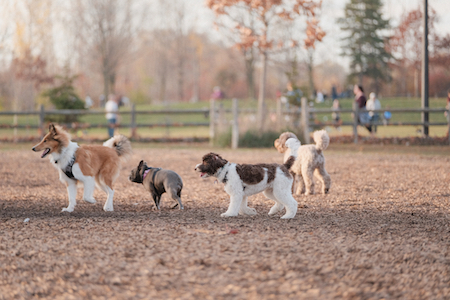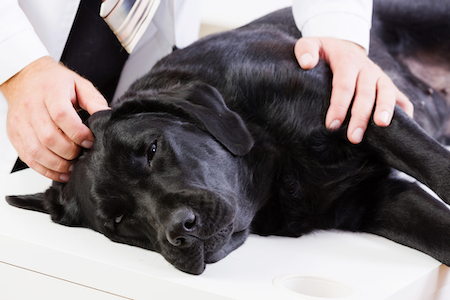What Pet Parents Need to Know About Canine Influenza
Posted: 11/06/2023 | BY: Erin Cain | Categories: Uncategorized
Canine influenza, more commonly known as the dog flu, is a serious illness affecting dogs of all ages. This virus is highly contagious and can be deadly in some cases. This article will discuss canine influenza and what pet parents need to know about this disease. Additionally, we’ll provide tips on protecting your dog from catching the flu.

Can dogs get the flu virus?
Yes, dogs can get the flu, but not the same way that people do. Canine influenza is different than the human flu. Although the symptoms may appear similar, canine influenza viruses are completely unrelated to those that cause infection in humans.
If your dog has flu-like symptoms, there’s a high chance they may be suffering from an upper respiratory tract infection (URI) via canine influenza. These URIs are serious because this type of infection can quickly become worse and cause complications in some cases. While the dog flu is rarely deadly, it merits immediate veterinary attention for diagnosis and your dog’s comfort. It’s also vital for dog owners to recognize their responsibility to keep infected dogs away from the canine population until the dogs recover.

What is the canine influenza virus?
The canine influenza virus (CIV) is a highly contagious virus that infects dogs and appears in two strains: H3N8 and H3N2. These strains of dog flu have caused thousands of dogs in America alone to get sick, with more than 30 states being affected. Southern California recently dealt with an outbreak leading to 800 confirmed cases and seven dog deaths.
In 2004, the H3N8 dog flu was first identified as an infectious disease of dogs; this strain evolved from equine influenza. The discovery came about in conjunction with a study conducted by researchers at the University of Florida on respiratory disorders among racing greyhounds. The H3N2 dog flu strain originated from Asia and evolved from the Asian avian influenza.
Unlike human seasonal flu varieties, CIV can affect any dog during their lives. The dog flu does not follow an annual pattern like other influenza types; it appears sporadically rather than occurring only once every year.
What causes the dog flu?
The dog flu virus is caused by either the CIV H3N8 or H3N2 viral strains. The highly contagious CIV can spread quickly because most dogs have no immunity against it unless they have been vaccinated. Dogs exposed to CIV often contract it from close contact with other infected dogs, such as at kennels, shelters, boarding facilities, and daycares. If you and your dog visit dog parks, be aware that dog parks are prime territory for the spread of CIV. Through shared food bowls or toys and exposure to airborne droplets shed by infected canines who bark, sneeze, or cough.
You should keep your pup isolated for seven days if infected with the H3N8 variant and 21 days if your dog has the H3N2 strain to prevent the spread of canine influenza. Good hygiene is another key to avoiding infection. Dog owners should practice good sanitation and handwashing and thoroughly clean shared items or kennels to reduce CIV spread. Influenza viruses do not usually survive beyond 48 hours outside their hosts’ bodies. Commonly used disinfectants like soap and water and heat above 60 degrees Fahrenheit are two quick methods to kill this virus.
Most dogs infected with CIV are no longer contagious after the seventh day from the onset of symptoms. However, some symptoms, like coughs, can linger, causing recovery within 2 – 3 weeks.

What are the symptoms of dog flu?
How can you tell if your dog has the dog flu? Canine influenza infections have dog flu symptoms that sometimes appear similar to other canine illnesses, such as kennel cough. Here are a few key signs and symptoms to look for, including:
- a productive (wet) cough that lasts more than a week
- lethargy
- coughing
- runny nose
- sneezing
- difficulty breathing
- fever (104 – 105 degrees)
- yellow or green nasal discharge (may also appear in the eyes)
- other respiratory secretions
- decreased appetite
- pneumonia
Dogs are most contagious during the second and fourth days of the virus incubation period. During this time, dogs transmit the virus through their nasal secretions, but not all dogs show signs of illness. The CIV can live up to 48 hours on surfaces and 24 minutes on clothing and fabrics. The virus can live on human hands for up to 12 hours. Even though it is airborne, direct contact with the virus will most likely result in sick dogs.
Canine influenza is rarely fatal, with a mortality rate of 10%; however, up to 20% of infected dogs will develop pneumonia and require hospitalization to recover from the illness. In those few cases, the viral infection causes too much damage via secondary bacterial infections and results in the dog’s death.

Is CIV contagious to people and other pets?
Canines are most contagious during the two to four-day virus incubation period. At this time, an infected dog can spread the dog flu from their nasal secretions; often, they do not show signs of illness at this early stage. While other dogs that infected canines come in contact with will contract CIV, there is no evidence that people can contract canine influenza.
Cats, however, may be another matter, based upon canine influenza cases.In 2016, a group of cats in an Indiana shelter contracted CIV from infected dogs within the same facility. The strain in question was the H3N2 CIV. It caused these cats to experience respiratory infection, including runny noses, excessive salivation, congestion, difficulty breathing, lethargy, and lip-smacking. The cats quickly recovered from the illness without incident. This situation has veterinary researchers exploring how contagious the H3N2 strain is when passed from a dog to a cat and then other cats afterward.
Researchers have not found further evidence of CIV outbreaks in cats. However, the Indiana case does prove that cats can become infected with the H3N2 virus specifically. Cat-to-cat transmission is also apparent in this case. It may be that cats in shelters or feral and indoor/outdoor cats have a more significant chance of exposure to the canine flu.

How is canine flu diagnosed and treated?
Dog flu is a highly contagious virus that pup parents cannot diagnose based on symptoms alone. The CIV symptoms are too similar to other canine medical conditions. To correctly identify the presence of the canine flu, your vet will need to perform laboratory tests on your dog to determine which CIV variant they have.
Treatment for CIV involves supportive care at home. Be sure that your dog has access to water to stay hydrated and keep her comfortable. Your veterinarian may give your dog fluids or prescribe non-steroidal anti-inflammatory drugs to manage her comfort levels. Dogs who develop secondary bacterial infections receive spectrum antibiotics for support.
Otherwise, the essential treatment for your dog — and other dogs nearby — is to keep your pup isolated until the veterinarian clears her of illness. That means no dog park or daycare or socializing with healthy dogs.
How to prevent CIV in your dog.
CIV vaccinations are a great way to protect your dog from canine influenza. A canine influenza vaccine is available for both the H3N8 and H3N2 viruses and can be combined in one shot. According to the Merck Animal Health manual, an effective immune response is established after two rounds of CIV vaccinations. Because the influenza virus can quickly spread between dogs, a dog vaccinated against it has far less risk of infection. Talk with your veterinarian about when to vaccinate your dog against this virus.
Other ways to prevent CIV contagion are:
- Keeping your dog away from other dogs who are or appear to be sick;
- Sanitize clothes, bedding, surfaces (food and water bowls), and clean your hands.

The best protection for your dog is pet insurance.
If your dog contracts CIV, she will at the least need to be seen by a veterinarian. Medications and treatment are added costs with that veterinary care. A pet insurance plan can ensure that your dog gets the care she needs and that you are reimbursed a percentage of the expenses from her vet bills.
Pet Insurance Review will find the best dog health insurance plans for you and your pup, and you can choose the provider and plan that fits your needs. Get a free pet insurance quote today, and be prepared for any medical issues your dog may face today and in the future.
References:
- Goodrich, J., McCrea, M. (2021). Dog flu: Roughly 800 cases, 7 deaths reported as sickness spreads, causing concerns. Retrieved from https://abc7chicago.com/dog-flu-2021-symptoms-california/11380921/
- Cornell University College of Veterinary Medicine. (n.d.). Canine Influenza Virus. Retrieved from https://www.vet.cornell.edu/animal-health-diagnostic-center/veterinary-support/disease-information/canine-influenza-virus
- The Ohio State University Veterinary Medical Center. (n.d.). Information regarding the Canine Influenza Virus. Retrieved from https://vet.osu.edu/vmc/referring-vets/news/information-regarding-canine-influenza-virus
- American Veterinary Medical Association. (2022). Canine Influenza: Pet Owners’ Guide. Retrieved from https://www.avma.org/resources/pet-owners/petcare/canine-influenza-pet-owners-guide
- University of Florida College of Veterinary Hospitals. (n.d.). Pet Owners H3N2 CANINE INFLUENZA VIRUS FACT SHEET. Retrieved from https://hospitals.vetmed.ufl.edu/files/2017/05/Info-for-Pet-Owners-on-Canine-Influenza-1.pdf
- Centers for Disease Control and Prevention. (2018). Key Facts about Canine Influenza (Dog Flu). Retrieved from https://www.cdc.gov/flu/other/canine-flu/keyfacts.html#serious
- Washington State Veterinary Medical Association. (2022). Canine influenza transmitted to cats in Indiana shelter. Retrieved from https://wsvma.org/2016/04/01/canine-influenza-transmitted-to-cats-in-indiana-shelter/
- Tonozzi, C. (2022). Canine Influenza. Retrieved from https://www.merckvetmanual.com/respiratory-system/respiratory-diseases-of-small-animals/canine-influenza-flu
The information contained on this blog is intended for informational and educational purposes only and should not be construed as medical advice. It is not a substitute for professional veterinary care. Always consult with your veterinarian before making any changes to your pet's health care or treatment plan.
The authors of this blog are not veterinarians and do not claim to be experts in pet health. The information provided here is based on our own experiences and research, as well as information from reputable sources. However, we cannot guarantee the accuracy or completeness of this information.
We encourage you to do your own research and consult with your veterinarian before making any decisions about your pet's health.
Compare top pet insurance providers plans.
Enter your dog’s age in years and months to calculate their age equivalent to human years.
Calculate your dog’s ageEnter your cat’s age in years and months to calculate their age equivalent to human years.
Calculate your cat’s age